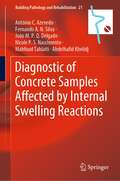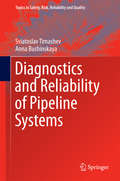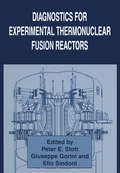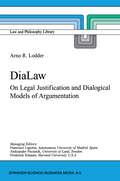- Table View
- List View
Diagnosis of Process Nonlinearities and Valve Stiction: Data Driven Approaches (Advances in Industrial Control)
by Ali Ahammad Choudhury Sirish L. Shah Nina F. Thornhillwere published in the series as the contributed volume, Process Control Performance Assessment: From Theory to Implementation with Andrzej Ordys, Damian Uduehi, and Michael Johnson as Editors (ISBN 978-1-84628-623-0, 2007). Along with this good progress in process controller assessment methods, researchers have also been investigating techniques to diagnose what is causing the process or control loop degradation. This requires the use of on-line data to identify faults via new diagnostic indicators of typical process problems. A significant focus of some of this research has been the issue of valve problems; a research direction that has been motivated by some industrial statistics that show up to 40% of control loops having performance degradation attributable to valve problems. Shoukat Choudhury, Sirish Shah, and Nina Thornhill have been very active in this research field for a number of years and have written a coherent and consistent presentation of their many research results as this monograph, Diagnosis of Process Nonlinearities and Valve Stiction. The Advances in Industrial Control series is pleased to welcome this new and substantial contribution to the process diagnostic literature. The reader will find the exploitation of the extensive process data archives created by today’s process computer systems one theme in the monograph. From another viewpoint, the use of higher-order statistics could be considered to provide a continuing link to the earlier methods of the statistical process control paradigm.
Diagnosis of the Nitrogen Status in Crops
by Gilles LemaireProviding a link between theoretical and applied aspects of plant nutrition and agriculture, this book introduces new concepts in plant nutrition. It shows how these can be applied in order to assess the nitrogen status in crops and to improve nitrogen nutrition through optimized N fertilization management. In this way economic benefits can be obtained, while at the same time preventing detrimental effects on the environment. The main agricultural crops - grasses, wheat, barley, Durum wheat, maize, sorghum, grain legumes and potatoes - are covered. The book will be an invaluable source for agronomists.
Diagnosis of the Powertrain Systems for Autonomous Electric Vehicles (Wissenschaftliche Reihe Fahrzeugtechnik Universität Stuttgart)
by Tunan ShenTunan Shen aims to increase the availability of powertrain systems for autonomous electric vehicles by improving the diagnostic capability for critical faults. Following the fault analysis of powertrain systems in battery electric vehicles, the focus is on the electrical and mechanical faults of the electric machine. A multi-level diagnostic approach is proposed, which consists of multiple diagnostic models, such as a physical model, a data-based anomaly detection model, and a neural network model. To improve the overall diagnostic capability, a decision making function is designed to derive a comprehensive decision from the predictions of various operating points and different models.
Diagnosis & Prognosis of AAR Affected Structures: State-of-the-Art Report of the RILEM Technical Committee 259-ISR (RILEM State-of-the-Art Reports #31)
by Victor E. SaoumaThis book presents the work of the RILEM Technical Committee 259-ISR. Addressing two complementary but fundamental issues: the kinetics of the reaction, and how this will affect the integrity of the structure (serviceability and strength), it also provides methodology for assessing past deterioration to enable readers to make engineering/science-based predictions concerning future expansion. The book is divided into six major topics: selection and interpretation of optimal monitoring system for structures undergoing expansion to monitor the progress of the swelling evolution and its consequences; development/refinement of current laboratory procedures to determine the kinetics of the reaction i.e. expansion vs (future) time, and to determine the kinetic characteristics of the time-dependent reaction to be used in a finite element simulation; extrapolation of results from structural component laboratory testing; selection of material properties based on data from existing structures affected by the alkali silica reaction or delayed ettringite formation; identification of critical features that should be present in a finite element code, development of test problems for validation, and a survey of relevant programs able to conduct a transient structural analysis of a structure undergoing chemically induced expansion; and lastly guidelines for finite element codes. The book is intended for practitioners responsible for concrete structures affected by the damaging alkali aggregate reaction, engineers dealing with aging structures, and researchers in the field.
Diagnostic Devices with Microfluidics (Devices, Circuits, and Systems)
by Francesco Piraino Šeila SelimovićThis book provides a current view of the research and commercial landscape of diagnostics devices, particularly those that utilize microscale technologies, intended for both patient and laboratory use. Common diagnostic devices that are based on microfluidic principles include glucose sensors for diabetic patients and over-the-counter pregnancy tests. Other diagnostic devices are being developed to quickly test a patient for bacterial and viral infections, and other diseases. The chapters, written by experts from around the world, discuss how to fabricate, apply, and market microfluidic diagnostic chips – for lab and at-home use. Most importantly, the book also contains a discussion of topics relevant to the private sector, including patient-focused, market-oriented development of diagnostics devices.
Diagnostic Devices with Microfluidics (Devices, Circuits, and Systems)
by Francesco Piraino Šeila SelimovićThis book provides a current view of the research and commercial landscape of diagnostics devices, particularly those that utilize microscale technologies, intended for both patient and laboratory use. Common diagnostic devices that are based on microfluidic principles include glucose sensors for diabetic patients and over-the-counter pregnancy tests. Other diagnostic devices are being developed to quickly test a patient for bacterial and viral infections, and other diseases. The chapters, written by experts from around the world, discuss how to fabricate, apply, and market microfluidic diagnostic chips – for lab and at-home use. Most importantly, the book also contains a discussion of topics relevant to the private sector, including patient-focused, market-oriented development of diagnostics devices.
Diagnostic Expertise in Organizational Environments
by Mark W. Wiggins Thomas LovedayDiagnostic Expertise in Organizational Environments provides a state-of-the-art foundation for a new paradigm in expertise research and practice. Skilled diagnosis is essential for accurate and efficient performance across a range of organizational contexts, including aviation, finance, rail, forensic investigation, firefighting, and medicine. However, it is also a complex process, subject to the abilities and experience of individual operators, the culture and practices of organizations, the relationships between operators, and the availability and usefulness of technology. As a consequence, diagnostic skills can be difficult to learn, maintain, and evaluate. This volume is a comprehensive approach that examines diagnostic expertise at the level of the individual practitioner, in the social context, and at the organizational level. The chapter authors comprise both academics and highly skilled practitioners so that there is a clear transition from understanding the problem of diagnostic skills to the implementation of solutions, either through redesign, training, and/or selection. It will appeal to those academics and practitioners interested and involved in this field and also prove useful to students of psychology, cognitive science education and/or computer interaction.
Diagnostic Expertise in Organizational Environments
by Mark W. Wiggins Thomas LovedayDiagnostic Expertise in Organizational Environments provides a state-of-the-art foundation for a new paradigm in expertise research and practice. Skilled diagnosis is essential for accurate and efficient performance across a range of organizational contexts, including aviation, finance, rail, forensic investigation, firefighting, and medicine. However, it is also a complex process, subject to the abilities and experience of individual operators, the culture and practices of organizations, the relationships between operators, and the availability and usefulness of technology. As a consequence, diagnostic skills can be difficult to learn, maintain, and evaluate. This volume is a comprehensive approach that examines diagnostic expertise at the level of the individual practitioner, in the social context, and at the organizational level. The chapter authors comprise both academics and highly skilled practitioners so that there is a clear transition from understanding the problem of diagnostic skills to the implementation of solutions, either through redesign, training, and/or selection. It will appeal to those academics and practitioners interested and involved in this field and also prove useful to students of psychology, cognitive science education and/or computer interaction.
Diagnostic of Concrete Samples Affected by Internal Swelling Reactions (Building Pathology and Rehabilitation #21)
by António C. Azevedo Fernando A.N. Silva João M.P.Q. Delgado Nicole P.S. Souza Mahfoud Tahlaiti Abdelhafid KhelidjThis book offers a complete diagnosis of concrete samples collected from a pile cap block of residential buildings affected by internal swelling reactions. Covering an extensive laboratory campaign to evaluate the transport properties of concrete samples, as well as their physical and chemical composition using advanced techniques to analyse cores extracted from real buildings that have concrete elements affected by internal swelling reactions (ISR). It features several rehabilitation procedures, pile caps repair and rehabilitation design, executed using strengthening procedures to provide the complete restoration of the structural integrity of the element deteriorated. These rehabilitation procedures proved to be a good solution to retrofit pile cap deteriorated by expansions due to internal swelling reactions of concrete. The book also offers a systematic review of the current state of knowledge and it is a valuable resource for scientists, students, and practitioners in various scientific and engineering disciplines, namely, civil and materials engineering, as well as and other interested parties.
Diagnostic Systems For Energy Equipments (Studies in Systems, Decision and Control #281)
by Vitalii P. Babak Serhii V. Babak Mykhailo V. Myslovych Artur O. Zaporozhets Valeriy M. ZvaritchThis book examines key issues in ensuring the operational reliability of energy facilities. In this regard, it analyzes mathematical models of diagnostic signals that arise during the operation of power equipment; reviews the main findings of research into their characteristics; presents diagnostics methods for selected types of electric power and heat engineering equipment; and covers a range of diagnostic and monitoring systems and devices for power equipment. Given its scope, the book offers a valuable resource for researchers, engineers and specialists, as well as instructors and graduate students at institutions of higher learning.
Diagnostic Techniques in Industrial Engineering (Management and Industrial Engineering)
by Mangey Ram J. Paulo DavimThis book presents the most important tools, techniques, strategy and diagnostic methods used in industrial engineering. The current widely accepted methods of diagnosis and their properties are discussed. Also, the possible fruitful areas for further research in the field are identified.
Diagnostic Ultrasound: Imaging and Blood Flow Measurements, Second Edition
by K. Kirk ShungOffers an Extensive Discussion on High Frequency UltrasoundBased on a course taught and developed by a foremost expert in diagnostic ultrasound technology, Diagnostic Ultrasound: Imaging and Blood Flow Measurements, Second Edition covers cutting-edge developments, along with the fundamental physics, instrumentation, system architecture, clinical ap
Diagnostic Ultrasound, Third Edition: Physics and Equipment
by Peter R. Hoskins Kevin Martin Abigail ThrushThis popular text provides a comprehensive, yet accessible, introduction to the physics and technology of medical ultrasound, with high quality ultrasound images and diagrams throughout. Covering all aspects of the field at a level that meetings the requirements of accredited sonography courses, it is ideal for both trainee and qualified healthcare professionals practising ultrasound in a clinical setting. Building on the content of previous editions, this third edition provides the latest guidance relating to ultrasound technology, quality assurance and safety and discusses the latest techniques.
Diagnostic Ultrasound, Third Edition: Physics and Equipment
by Peter R Hoskins, Kevin Martin and Abigail ThrushThis popular text provides a comprehensive, yet accessible, introduction to the physics and technology of medical ultrasound, with high quality ultrasound images and diagrams throughout. Covering all aspects of the field at a level that meetings the requirements of accredited sonography courses, it is ideal for both trainee and qualified healthcare professionals practising ultrasound in a clinical setting. Building on the content of previous editions, this third edition provides the latest guidance relating to ultrasound technology, quality assurance and safety and discusses the latest techniques.
Diagnostics and Reliability of Pipeline Systems (Topics in Safety, Risk, Reliability and Quality #30)
by Sviatoslav Timashev Anna BushinskayaThe book contains solutions to fundamental problems which arise due to the logic of development of specific branches of science, which are related to pipeline safety, but mainly are subordinate to the needs of pipeline transportation. The book deploys important but not yet solved aspects of reliability and safety assurance of pipeline systems, which are vital aspects not only for the oil and gas industry and, in general, fuel and energy industries , but also to virtually all contemporary industries and technologies.The volume will be useful to specialists and experts in the field of diagnostics/ inspection, monitoring, reliability and safety of critical infrastructures. First and foremost, it will be useful to the decision making persons —operators of different types of pipelines, pipeline diagnostics/inspection vendors, and designers of in-line –inspection (ILI) tools, industrial and ecological safety specialists, as well as to researchers and graduate students.
Diagnostics for Experimental Thermonuclear Fusion Reactors
by Giuseppe Gorini Elio Sindoni Peter E. StottThis book of proceedings collects the papers presented at the Workshop on Diagnostics for ITER, held at Villa Monastero, Varenna (Italy), from August 28 to September 1, 1995. The Workshop was organised by the International School of Plasma Physics "Piero Caldirola. " Established in 1971, the ISPP has organised over fifty advanced courses and workshops on topics mainly related to plasma physics. In particular, courses and workshops on plasma diagnostics (previously held in 1975, 1978, 1982, 1986, and 1991) can be considered milestones in the history of this institution. Looking back at the proceedings of the previous meetings in Varenna, one can appreciate the rapid progress in the field of plasma diagnostics over the past 20 years. The 1995 workshop was co-organised by the Istituto di Fisica del Plasma of the National Research Council (CNR). In contrast to previous Varenna meetings on diagnostics, which have covered diagnostics in present-day tokamaks and which have had a substantial tutorial component, the 1995 workshop concentrated specifically on the problems and challenges of ITER diagnostics. ITER (the International Thennonuclear Experimental Reactor, a joint venture of Europe, Japan, Russia, and the United States, presently under design) will need to measure a wide range of plasma parameters in order to reach and sustain high levels of fusion power. A list of the measurement requirements together with the parameter ranges, target measurement resolutions, and accuracies provides the starting point for selecting a list of candidate diagnostic systems.
Diagnostics for Experimental Thermonuclear Fusion Reactors 2
by Peter E. Stott Giuseppe Gorini Paolo PrandoniThis book of proceedings collects the papers presented at the workshop on "Diagnostics for Experimental Fusion Reactors" held at Villa Monastero, Varenna (Italy) September 4-12, 1997. This workshop was the seventh organized by the International School of Plasma Physics "Piero Caldirola" on the topic of plasma diagnostics and the second devoted to the diagnostic studies for the International Thermonuclear Experimental Reactor (ITER). The proceedings of the first workshop on ITER diagnostics were published by Plenum Press in 1996 with the title "Diagnostics for Experimental Thermonuclear Fusion Reactors". While many of the ideas and studies reported in the first workshop remain valid, there has been sub stantial progress in the design and specification of many diagnostics for ITER. This moti vated a second workshop on this topic and the publication of a new book of proceedings. ITER is a joint venture between Europe, Japan, Russia and USA in the field of con trolled thermonuclear fusion research. The present aim of ITER is to design an experimental fusion reactor that can demonstrate ignition and sustained burn in a magnetically confined plasma. To achieve this goal, a wide range of plasma parameters will have to be measured reliably. It is also anticipated that diagnostics will be used much more extensively as input to control systems on ITER than on present fusion devices and this will require increased relia bility and long-term stability.
Diagnostics in Plant Breeding
by Thomas Lübberstedt and Rajeev K. Varshney“Diagnostics in Plant Breeding” is systematically organizing cutting-edge research reviews on the development and application of molecular tools for the prediction of plant performance. Given its significance for mankind and the available research resources, medical sciences are leading the area of molecular diagnostics, where DNA-based risk assessments for various diseases and biomarkers to determine their onset become increasingly available. So far, most research in plant genomics has been directed towards understanding the molecular basis of biological processes or phenotypic traits. From a plant breeding perspective, however, the main interest is in predicting optimal genotypes based on molecular information for more time- and cost-efficient breeding schemes. It is anticipated that progress in plant genomics and in particular sequence technology made recently will shift the focus from “explanatory” to “predictive” in crop science. This book assembles chapters on all areas relevant to development and application of predictive molecular tools in plant breeding by leading authorties in the respective areas.
Diagnostics of Mechatronic Systems (Studies in Systems, Decision and Control #345)
by Pavol Božek Yury Nikitin Tibor KrenickýThis book provides novel approach to the diagnosis of complex technical systems that are widely used in various kinds of transportation, energy, metallurgy, metalworking, fuels, mining, chemical, paper industries, etc.Effective diagnostic systems are necessary for the early detection of errors in mechatronic systems, for the organization of maintenance and for the assessment of the performed service quality. Unfortunately, the practical use of AI in the diagnosis of mechatronic systems is still quite limited and the inability to build effective mechatronic systems leads to significant economic losses and dangers. The main aim of this book is to contribute to knowledge within the topic of diagnostics of mechatronic systems by the analysis of the elements reliability characteristics, using methods, models and algorithms for diagnostics and by studying examples of model diagnostic systems using AI methods based on neural networks, fuzzy inference systems and genetic algorithms.
Diagnostics of Rotating Machines in Power Plants: Proceedings of the CISM/IFToMM Symposium, October 27–29, 1993, Udine, Italy (CISM International Centre for Mechanical Sciences #352)
by G. DianaThe papers presented on this occasion examined the most significant aspects of diagnostic strategies, emphasizing the importance of predictive maintenance in reducing production shortages and the costs of plant management. The contributions of these authors allow a critical comparison of the varied experiences in developing and applying the different diagnostic methodologies employed in several parts of the world. The following problems are discussed: characteristics of condition monitoring systems - data acquisition techniques and data processing methodologies; choice of transducers and of measurement point locations; data compression techniques; alarm levels evaluation (acceptance regions); strategies for detecting malfunction conditions; diagnostic methodologies for the on-line and off-line identification of the cause of fault; expert systems; definition of the guidelines for the presentation in control rooms of monitoring data and diagnostic results; rotordynamic models used, off-line, to confirm faults diagnosed on-line.
Diagrams and Gestures: Mathematics, Philosophy, and Linguistics (Lecture Notes in Morphogenesis)
by Francesco La Mantia Charles Alunni Fernando ZalameaDrawing a line, and then another, and another. Go back from the lines to the movements they capture and see gestures in them: not spatial displacements, but modes of knowledge that pass through the exercise of the body. Discovering something new in a gesture: the line that contracts into a point or the point that expands into a zone, perhaps sinking into a hole. Thus experiencing a diagram: a becoming other inscribed in the novelty of the gesture and in the changes of the forms it shapes. This and much more is discussed in the essays gathered in Diagrams and Gestures. Resulting from trans-disciplinary work between mathematicians, philosophers, linguists and semioticians, the volume delivers an up-to-date account of the most valuable research on the connections between gesture and diagram. As one of the most important themes in contemporary thought, the study of these connections poses a challenge for the future: to elaborate a theory that is equal to new and stimulating research methodologies. We call this theory a philosophy of diagrammatic gestures.
DiaLaw: On Legal Justification and Dialogical Models of Argumentation (Law and Philosophy Library #42)
by A.R. LodderThis book is a revised version of my dissertation 'DiaLaw - on legal th justification and dialog games' that I defended on June 5 1998 at the Universiteit Maastricht. The chapters 1, 4 & 5 (now: 1, 5 & 6) of my dissertation have remained largely unaltered. In chapter 2 I added explicitly the distinction between constructing legal justification and reconstructing it, and tried to elucidate the differences (and similarities) between the product and process of justification. Chapter 3 is divided into two chapters: one on the general characteristics of DiaLaw (now: chapter 3), and the other on specific, legal characteristics of DiaLaw (now: chapter 4). In order to improve readability, all rules in these chapters have been rewritten considerably. The section on the implementation of DiaLaw is moved to the appendix. In chapter 7 (the former chapter 6), a discussion of the notions 'procedural' and 'structural' arguments is added, and different layers in argumentation models are discussed. Finally, in chapter 8 (the former chapter 7) is added a recapitulation of my view on legal justification, and a discussion on the future use in legal practice of dialog models that represent argumentation in a natural way. The main thesis has remained unaltered: legal justification should be modeled as a procedural, dialogical model in which not only products of argumentation are allowed, but, even in formal models, rhetorical, psychological aspects of argument are dealt with.
Dialect Accent Features for Establishing Speaker Identity: A Case Study (SpringerBriefs in Speech Technology)
by Manisha Kulshreshtha Ramkumar MathurDialect Accent Features for Establishing Speaker Identity: A Case Study discusses the subject of forensic voice identification and speaker profiling. Specifically focusing on speaker profiling and using dialects of the Hindi language, widely used in India, the authors have contributed to the body of research on speaker identification by using accent feature as the discriminating factor. This case study contributes to the understanding of the speaker identification process in a situation where unknown speech samples are in different language/dialect than the recording of a suspect. The authors' data establishes that vowel quality, quantity, intonation and tone of a speaker as compared to Khariboli (standard Hindi) could be the potential features for identification of dialect accent.





















